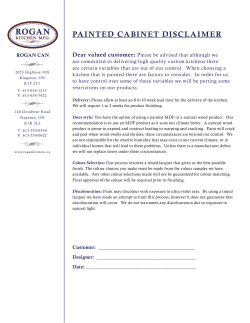
COLOUR THEORY PROJECT
COLOUR THEORY PROJECT The Science Of Colour Newton 1676 • Newton proved his theory that light travelled in straight lines not waves as previously thought. • He also proved that light is made of particles not waves. Subtractive Colour • A subtractive color model shows the mixing of a set of colourants to create a wider range of colours. • Subtractive colour systems use white light between the viewer and the light source which subtract waveleng ths from the light, giving it colour. Additive Colour • Additive colour is color created by mixing light of two or more colours. The additive primary colours are normally used in additive colour system. • It used darkness in the light sources of different wavelengths that are added in proportions to produce a range of colours. Johannes Itten’s Colour Wheel • Ittens Colour Wheel is an abstract illustrative organization of colour hues around a circle that shows the relationships between primary, secondary and complimentary colours. • Itten established the colour wheel in the 1920’s. The Qualities Of Colour: Hue, Value & Saturation • HSV is most common cylindrical coordinate representations of points in an RGB colour model. • It was developed in the 1970s for computer graphics applications, and today is used in colour pickers in image editing software, and in image analysis and computer vision. Primary Colours • Primary colours are colours that can be combined to make a range of secondary colours. • These primary colours are red, yellow and blue. Secondary Colours • Secondary colours are made up from the primary colours. • These secondary colours are green, orange and purple. Complimentary Colours • Complimentary colours lie opposite each other on the colour wheel. • Complementary colors are pairs of colours that are of opposite hue. Mixed Complimentary Colours • In colour theory, two colours are called complementary when mixed in the right proportion and they produce a neutral colour. Contrast Of Hue • Contrast of hue is the interaction of two or more different colours. Contrast Of Value • Contrast of value is the interaction of lightness or darkness. Cold Warm Contrast • The spectrum is divided into two sets of hues based on the temperature commonly associated with the hues. • This contrast has been called cold and warm contrast, contrast of temperature, or humidity contrast. Complimentary Contrast • Complementary Contrast is the interaction of one set of complement colours. Simultaneous Contrast • Simultaneous Contrast is the effect of colours upon each other, gray or black can shift toward the complement of the colour with which they're placed. Colour Harmonies • There are many theories for harmony. There are 3 colour shemes that present the basic colour harmony formulas. • 1. A colour scheme based on analogous colors • 2. A colour scheme based on complementary colors • 3. A colour scheme based on nature Monochromatic • Monochromatic colour relies on only one colour family to create a design. • It uses a combination of tints, tones, and shades from the same family to achieve the desired effect. Analogous • Analogous colour schemes use colours that are next to each other on the colour wheel. • They usually match well and look natural and comfortable. • Analogous colour schemes are often found in nature. They are harmonious and pleasing to the eye. Tints • Tints are the lighter value of a pure hue, made by adding white. Shades • Shade has a darker value of a pure hue, made by adding black. Warm Colours • Warm colours are colors starting with yellow and continuing to redviolet on the color wheel, which convey warmth to a viewer. Cool Colours • Cool colours are colors starting with yellow-green & including violet that give a cool feeling. Triadic Colour Scheme • A triadic colour scheme uses colours that are evenly spaced around the colour wheel. • Triadic colour harmonies tend to be quite vibrant, even if pale or unsaturated versions of hues are used. Tetradic • The tetradic colour scheme makes use of a combination of four colours, which sit opposite each other on the colour wheel in two complementary pairs.
© Copyright 2025










